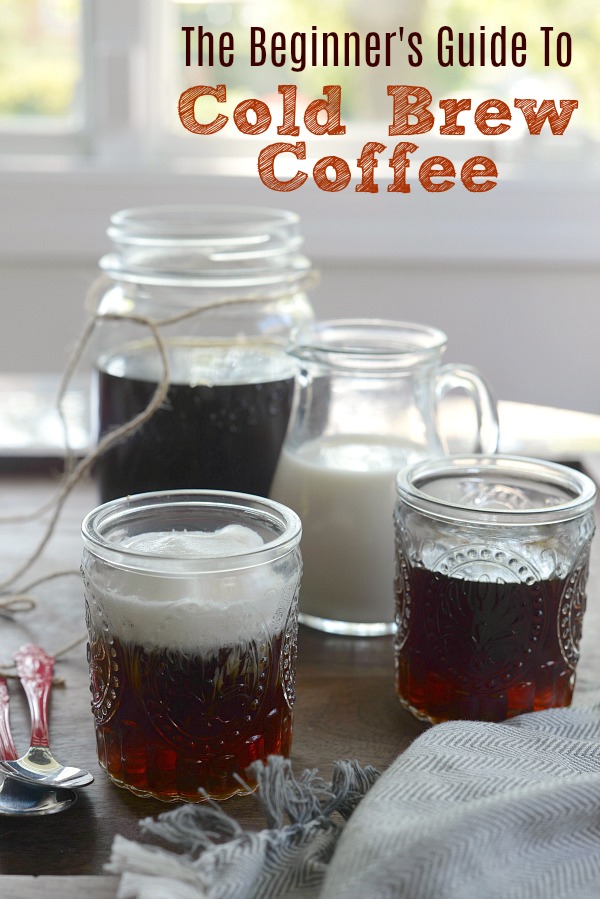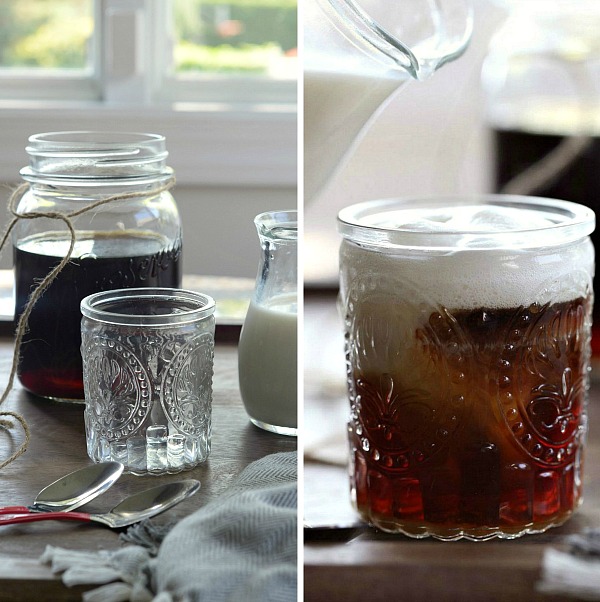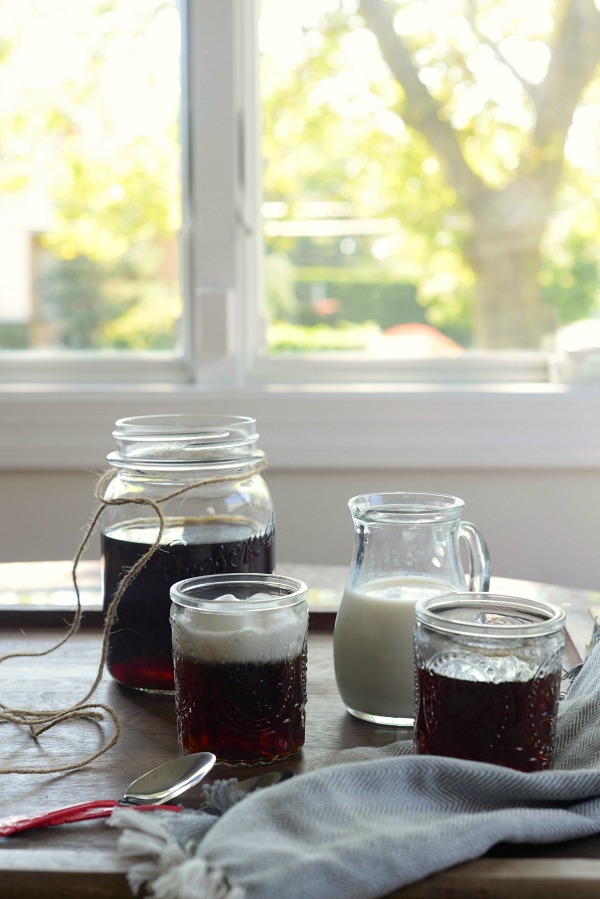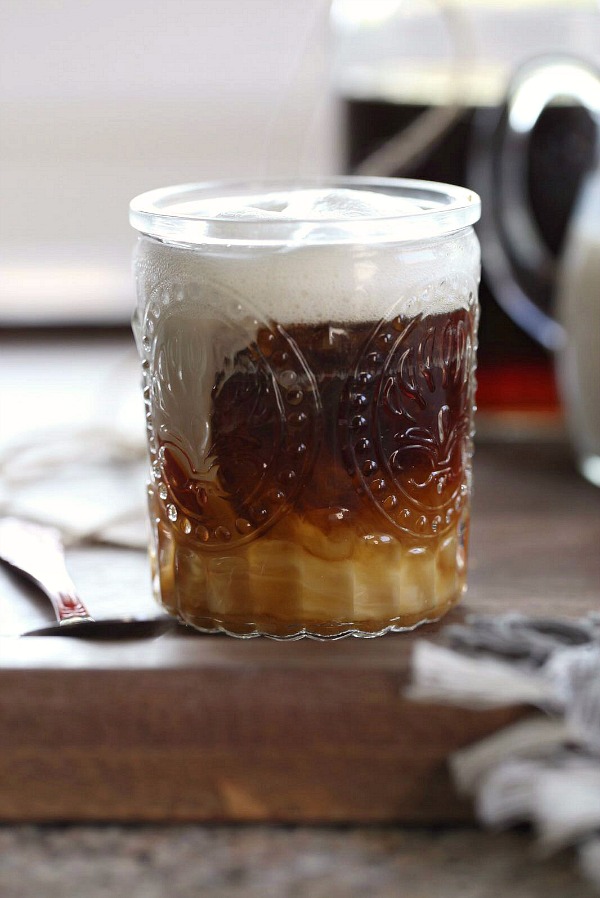
I have so much to say about cold brew coffee that I don’t even know where to begin! As many of you know, I have become quite obsessed with making my own cold brew coffee at home and I’ve spent countless hours researching and testing ratios, coffee grinds, and brewing methods. I even went live on Instagram to make cold brew (with my 9 year old son, who was eager to pour the coffee grounds into the pitcher before going to bed) and spent some time answering many of your questions. Cold brew coffee isn’t just about mixing together ground coffee beans and water. There’s a method to the madness and I’m excited to share my favorite recipe and tips with you in this post. Please comment below if you have any questions that I didn’t answer and I will hopefully be able to help!

WHAT IS THE DIFFERENCE BETWEEN COLD BREW AND ICED COFFEE?
The basic answer is that cold brew coffee is less acidic than ice coffee, which is hot brewed coffee (possibly cooled down) with ice. When beans are brewed with hot water, oils are extracted from the beans that won’t dissolve at lower temperatures and these oils are what give hot coffee the acidity it’s known for. Don’t get me wrong. I LOVE hot coffee and I drink it all winter long so I’m not trashing it! Okay, now that it’s out of the way, next step is explaining the benefit of cold brewing for that less acidic cup of coffee. Cold brew is never exposed to heat and it brews using the method of time. It’s basically “set it and forget it” then strain and drink.
BUT IS COLD BREW REALLY BETTER THAN ICED COFFEE?
It really matters what you’re looking for from your coffee. Since the cold brew method does not extract the oils from the bean, the flavor will be more mild and the actual nuances of the bean will be muddled. If you buy a bean that has notes of chocolate, flowers, peanuts, berries, wine, etc., you will most likely not taste those flavors with the cold brew method. So this really becomes a personal choice. Less acidic mellow coffee vs. more acidic coffee with distinguishable flavors.
WHY COARSE GROUND COFFEE?
While the coffee brews at room temperature, you want water to pass through the coffee grounds without over-saturating the beans. The finer the grind, the more contact the water has with the bean and it can over-extract the oils from the coffee. That means bitter cold brew and nobody wants that, right?? A coarse grind is known as the “sweet spot” where coffee is extracted to be sweet and long lasting on your palate. Interestingly enough, if the coffee bean is too coarse (imagine just adding water to a whole coffee bean or one crushed up with just a hammer), the coffee will be salty, sour and acidic from not enough saturation. The kind of coarse ground coffee to look for when making cold brew coffee should looks similar to sea salt. You want to see some small pieces of coffee bean in the grind. Imagine being on one of those beaches where they are tiny rocks everywhere that are seriously painful when you walk on them? Yeah, that’s kind of what you want to see. Click HERE for the ultimate coffee grind size chart and you’ll see what I mean.
WHAT ARE SOME DIFFERENT METHODS TO MAKE HOMEMADE COLD BREW COFFEE?
DIY Pitcher/Large Container: this is my favorite method because it’s easy for anyone to make at home. You don’t need any special equipment. What you will need are a pitcher or large container and a cover, a strainer (preferably a mesh sieve), cheesecloth or a clean tea towel, and a pitcher or jar to store the cold brew in your fridge. You literally just stir together the ground beans and water and set it on the counter for up to 24 hours to brew. To strain, line a strainer with cheesecloth or a clean tea towel and pour the brewed coffee through the strainer into a bowl or straight into your pitcher and that’s it!
Immersed Strainer: this is similar to the DIY method but in this case, you’ve purchased a cold brew gadget with a strainer build in. In this case, you put the ground beans into the strainer and place it directly inside of the pitcher of water. After 24 hours, remove the strainer and the coffee is ready to drink. If any of the beans get into the cold brew, make sure to strain it once through a cheese cloth or tea towel or those tiny little granules will make your coffee bitter after a few days in the fridge. This Large Cold Brew Coffee Maker is a great option and I love the look!
Toddy Cold Brew System: The Toddy is a cold brew system that comes with a plastic brew container, glass carafe and filters. The coffee and water are gently combined in the brew container with the filter in the bottom and a rubber stopper to keep the coffee from leaking. The container is placed over the glass carafe and set aside for 24 hours. When the coffee is ready to strain, remove the rubber stopper and the coffee passes through the strainer directly into the glass carafe and goes right into the fridge. The filter can be washed and used up to 10 times before replacing. To purchase the Toddy that I use in my home (when I’m not using the DIY method above), click HERE.
French Press: yes, you can use a French press to make cold brew BUT the strainer is not fine enough so you will need to strain the brewed coffee once through a cheese cloth or tea towel. And unless your French press is extra larger, like the Bodum BRAZIL French Press,you will only be able to make one or two batches of cold brew at a time.
WHAT IS COLD BREW CONCENTRATE?
Cold brew concentrate is simply a smaller ratio of coarse coffee grounds to water. The less water you use to cold brew the coffee, the more concentrated it will be. When you make your own concentrate, you will want to add water and/or a ton of ice to the cold brew when serving. When I make cold brew concentrate, I generally use a ratio of 1:3 (1 cup coarse ground coffee and 3 cups water).
CAN I USE DECAF COFFEE BEANS TO MAKE COLD BREW?
Um…you can…but why they heck would you do that?!?!? Okay, okay, yes, you can make cold brew with decaf coffee beans but it’s important to note that even decaf coffee still has some caffeine in it. Caffeine is removed by softening the bean using a solvent, such as carbon dioxide and it’s not a perfect system. There will always be some caffeine left in that bean.
WHAT CAN I ADD TO MY COLD BREW COFFEE?
If you’re making a concentrate (see ratio above), definitely start by adding some water to dilute the cold brew. A few pieces of ice are always welcome because after all, this is COLD brew, right?!? If you’re making the recipe below, all you need is some ice and milk; whole milk, half and half, almond milk, cashew milk, coconut milk. If you love your milk foamy like I do, I highly recommend the Capresso frothPRO. If you are using almond milk, Blue Diamond and Trader Joe’s unsweetened almond milk are your best option for a super frothy addition to your cold brew coffee.
HOW TO BUY COARSE GROUND COFFEE BEANS FOR COLD BREW?
If you are buying coffee in your local supermarket, buy whole beans and ask if they have a coffee grinder. Make sure they grind the coffee on the coarsest setting. I suggest Fairway or Whole Foods, if those are available where you live. Please note that Trader Joe’s coarse grind setting isn’t coarse enough but it will do in a pinch. Just brew the coffee for 20 hours instead of 24.
Below are a few websites where you can buy your coarse ground beans. If you have a favorite website where you order from, please let me know and I will add it to this list.
The Roasters Collective
The Chosen Bean
Zeke’s Coffee (recommended by @cookinginheelss)

The Beginner’s Guide To Cold Brew Coffee
Ingredients
- 1 cup coarsely ground coffee (you actually want to see pieces of the coffee bean or it’s not coarse enough)
- 5 cups filtered water
Special Equipment
- large container or pitcher
- a strainer, such as a fine mesh sieve
- cheesecloth
- a container for storing the cold brew
Instructions
Immersion Cold Brew Method
- Place coffee ground into a large container or pitcher. Pour the water on top then gently stir with a spoon. You want all of the coffee to be saturated with water.
- Cover the container and set aside on the counter at room temperature for 20-24 hours. Do not exceed 24 hours or the coffee beans will over-extract and your coffee will be bitter.
- Line a strainer with cheesecloth and place over a large bowl. Pour the brewed coffee through the strainer to catch all of the coffee grounds so they don’t end up in your coffee. If there are any little pieces of coffee grounds that passed through the strainer, repeat this process a second time until your cold brew coffee is clear.
- Transfer the coffee to a jar or pitcher and store in the fridge for up to 4 weeks.
Notes
- The important thing to note about making homemade cold brew coffee is that you can experiment with different ratios of coffee to water, different kinds of coffee beans, and how long the coffee brews at room temperature. Personally, I like a medium roast coffee cold-brewed for 24 hours and a dark roast for 20 hours. Have some fun and find your sweet spot!
Thank you to Miriam Pascal from overtimecook.com and Danielle Renov from peaslovencarrots.com for all of your help with the photos in this post. I’m in love with every photo and I have both of you to thank!




